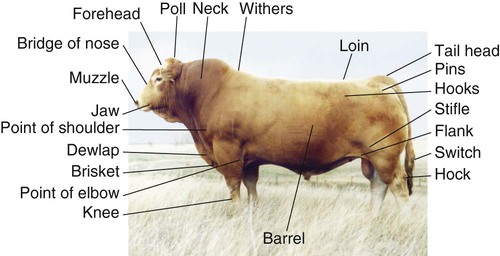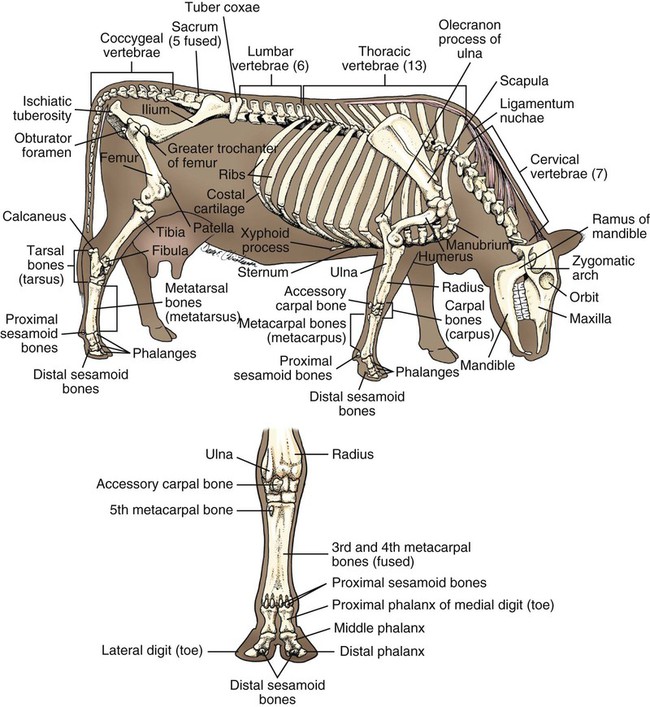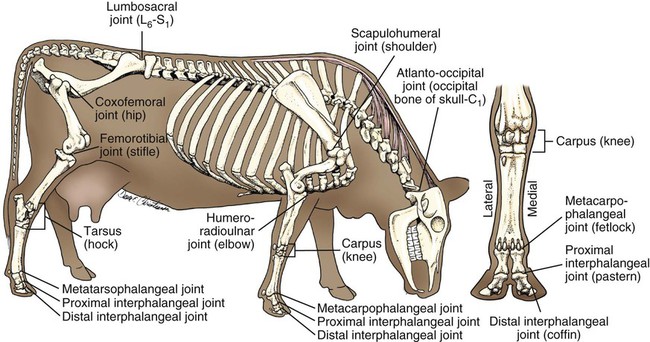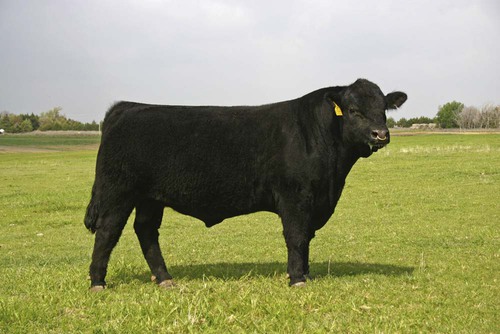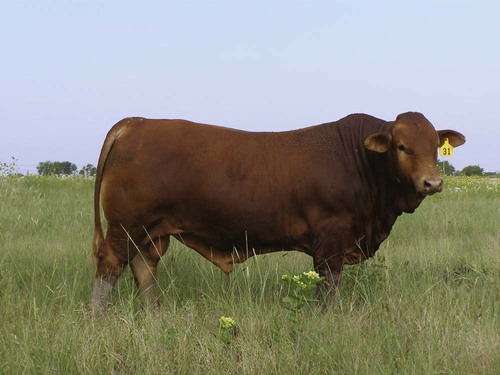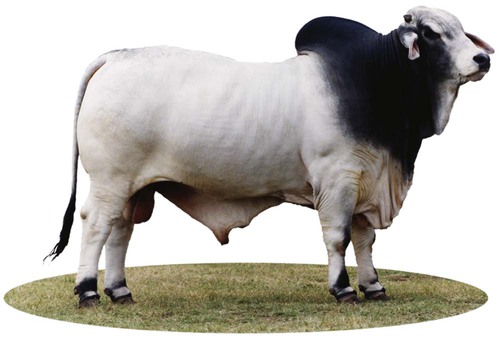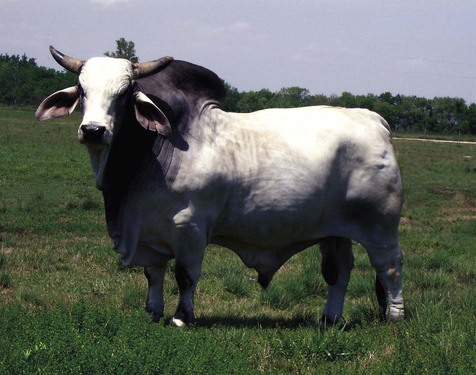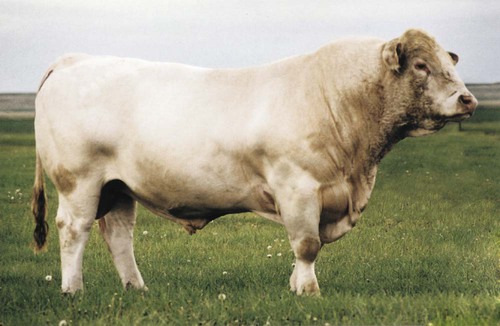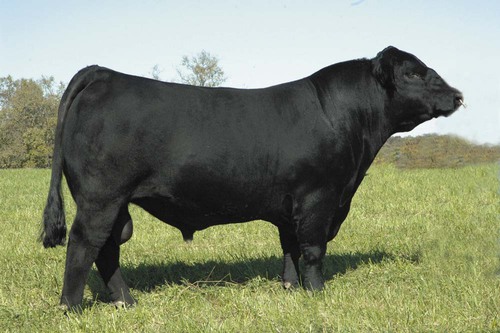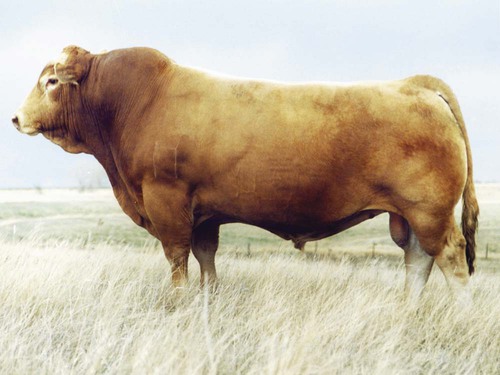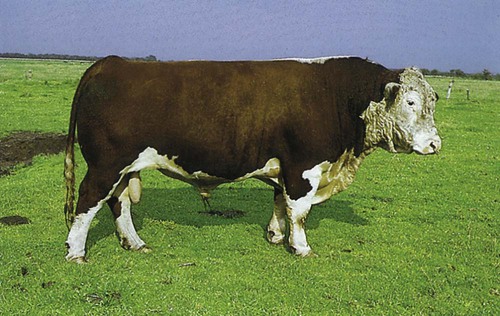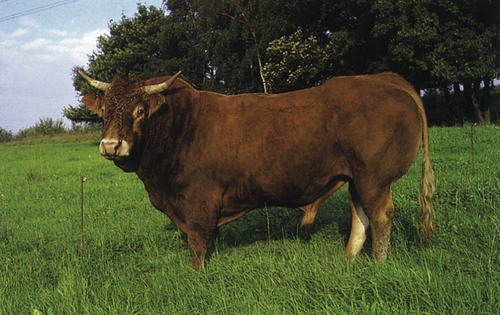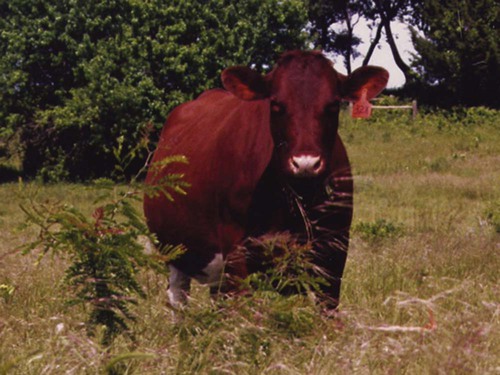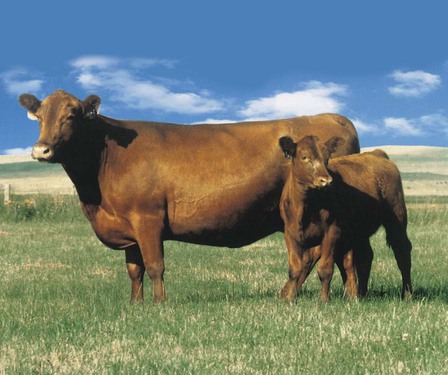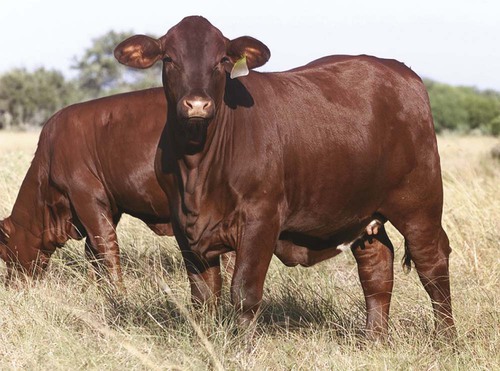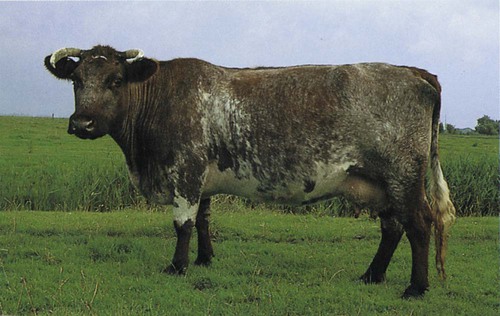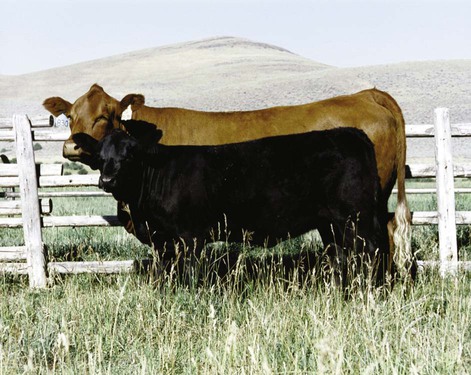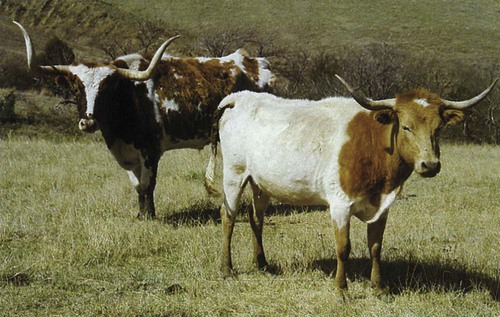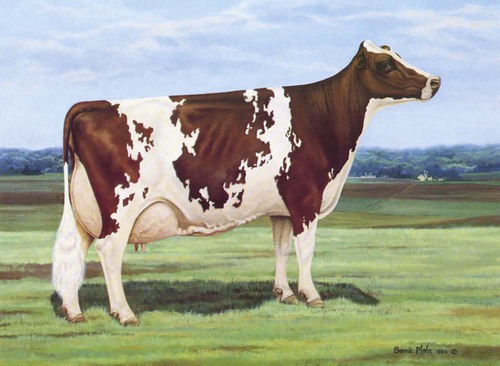When you have completed this chapter you will be able to • Know and understand the zoologic classification of the species • Know and be able to proficiently use terminology associated with this species • Know normal physiologic data for the species and be able to identify abnormal data • Identify and know the uses of common instruments relevant to the species • Describe prominent anatomical or physiologic properties of the species • Identify and describe characteristics of common breeds • Describe normal living environments and husbandry needs of the species • Understand and describe specific reproductive practices of the species • Understand specific nutritional requirements of the species Box 10-1 lists common terminology used to describe the age and breeding status of cattle. Table 10-1 lists normal physiologic data for cattle. TABLE 10-1 Normal Physiologic Data for Cattle The Salers breed of cattle is native to the Auvergne region of south central France. The Salers is a horned breed. Salers cattle are a dark mahogany red. One strain of Salers is naturally polled, and some strains are black. Salers cows are noted for their ease of calving and their good maternal ability. Other desirable characteristics of Salers cattle include good foraging ability on poor range, high weaning weights, and excellent carcass quality that meets current market demand for beef. American Salers cattle can be registered with the American Salers Association (Fig. 10-4). The official name of the Angus breed is the Aberdeen-Angus. The breed originated in Scotland in the shires of Aberdeen and Angus. Angus cattle are black. They have a smooth hair coat and are polled. They are an alert and vigorous breed. Angus cattle perform well in the feedlot. They produce a desirable carcass of high-quality, well-marbled meat. Nearly all Angus are pure for the dominant polled gene. When the Angus is used in crossbreeding programs, nearly all the calves are polled. A few Angus carry a red recessive gene for red color. Sometimes, a red C is born to black parents. The red calf is not eligible for registry in the American Angus Association. Angus cattle crossbred to Hereford cattle will produce what is known as a black baldy, which is a black calf with a white face. Another possible coloration is a black brockle-faced calf, which is a black calf with a white face, but the face has a black pattern throughout it (Fig. 10-5). The Beefmaster breed began in Texas. The breed is the result of crosses among Herefords, Shorthorns, and Brahmans. The breed has a variety of colors. Reds and duns are more common than other colors. Some of the cattle are horned and some are polled. The cattle have drooping ears and loose hide. Selection has been mainly for good disposition, fertility, gain, conformation, hardiness, and milk production. The three breed associations for this breed are Beefmaster Breeders Universal, the Foundation Beefmaster Association, and the National Beefmaster Association (Fig. 10-6). The Brahman breed was developed in the southwestern part of the United States from Bos indicus type cattle imported from India. Brahman cattle vary from very light gray or red to almost black. The bulls have dark areas on the neck and shoulders. They have drooping ears, loose hide, a pendulous sheath, and a hump over their shoulders. The major use of Brahman in the United States is crossing with other breeds. The resulting hybrids have proved to be desirable beef animals. Cattle of this breed can be registered with the American Brahman Breeders Association (Figs. 10-7 and 10-8). The Brangus breed was developed in the United States by crossing Brahman and Angus cattle. Brangus cattle are solid black and polled. Brangus have drooping ears and loose hide. Bulls have a small hump over the shoulders. They are adaptable to different climates. They have good mothering ability and feed efficiency, and they produce desirable carcasses. Cattle of this breed must undergo an inspection to determine conformation and breed character before the animals can be registered with the American Brangus Breeders Association (Fig. 10-9). The Charolais breed originated in France. Charolais cattle are white to light straw color with pink skin. They are large and heavily muscled. Mature bulls weigh 2000 to 2500 lb, and mature cows weigh 1500 to 1800 lb. Most are naturally horned. Their horns are white, slender, and tapered. Charolais have a high feed efficiency. They are well adapted to many areas and are used in many crossbreeding programs. Naturally polled Charolais can also be registered. Cattle of this breed can be registered with the American International Charolais Association (Fig. 10-10). The Hereford breed originated in England. Hereford cattle have white faces and red bodies, ranging from yellow to dark red. They have white on the dewlap, underline, flank, and switch. Herefords can be polled or horned. They have a docile nature and are easily handled. They have a superior foraging ability, vigor, and hardiness. They produce more calves under adverse conditions than do many other breeds. When Herefords are used in crosses, the white color pattern tends to be dominant. Mature bulls weigh about 1800 lb, and mature females weigh about 1200 lb. Horned Herefords can be registered with the American Hereford Association. Polled Herefords are eligible for registration with both the American Hereford Association and the American Polled Hereford Association (Fig. 10-13). Limousin cattle originated in France. They have a mahogany red to gold color with a light tan underline, muzzle, and legs. The skin is free of pigmentation. The spread of horns is horizontal, then forward and upward. The Limousin head is small and short with a broad forehead. The neck is also short. Mature bulls weight from 2000 to 2400 lb, and mature cows weight about 1350 lb. Limousin cattle are noted for their carcass leanness and large loin areas (Fig. 10-14). The Maine-Anjou originated in France. They have dark red with white undermarkings and patches of white on the body. Some cattle are roan. They are large in size and have lightly pigmented skin. They are a horned breed with medium-sized horns that curve forward. They are considered docile and easily handled. They are fast growing and have a well-marbled carcass. Mature bulls weight about 2750 lb (Fig. 10-15). Red Angus herds began in the United States about 1945. The herds developed from crossing red with the red from Black Angus cattle. Because the red gene is recessive, the offspring of the red crosses are always red. Red Angus can be registered with the Red Angus Association of America. Because red absorbs less heat than black, Red Angus cattle can tolerate warmer temperatures than Black Angus. Red Angus cattle have many of the same characteristics of Black Angus, except their color (Fig. 10-16). The Santa Gertrudis breed was developed on the King Ranch in Texas. The breed is a result of crosses of Brahman bulls with Shorthorn cows. The cattle have a cherry red color with occasional white markings. They have drooping ears. The cattle also have loose skin. The hair grows short and straight in warm climates and long in colder climates. Most of the animals are horned, although some are polled. Santa Gertrudis cattle are eligible for registration with the Santa Gertrudis Breeders International. They produce desirable carcasses with little waste fat. They also have a tendency to resist diseases and insects (Fig. 10-17). The Shorthorn breed originated in England. They are red, white, or roan. They have small horns that curve inward or are polled. They are easily handled and have good dispositions. Mature bulls weigh up to 2400 lb, and mature cows weigh up to 1500 lb. Shorthorns are adaptable to many climates. They have excellent crossing ability with other breeds. They are good mothers with excellent milking ability. Shorthorns produce a desirable carcass. Cattle of this breed can be registered with the American Shorthorn Association (Fig. 10-18). Simmental cattle originated in the Simmen Valley of Switzerland. Simmental cattle can be red and white, yellow and white, black and white, gray and white, or solid. They are a horned breed with medium-sized horns. The Simmental is a large-bodied animal and is noted for being docile. Mature bulls weigh from 2300 to 2600 lb, and mature cows weight about 1450 to 1800 lb. They have extremely rapid growth rates, are thickly muscled, and produce a carcass without excess fat. They are adaptable to a wide variety of climates. Cattle of this breed can be registered with the American Simmental Association (Fig. 10-19). The Texas Longhorn developed in Spain. They have many shades and combinations of colors. They have horns that curve upward and spread to 4 feet or more. Their legs are long, and their shoulders are large and high. They have a large head with small ears and long hair between their horns. Their neck is short and stocky. They are slow to mature, have high fertility, are resistant to many diseases and parasites, and are well adapted to harsh environments. They have the ability to survive on sparse rangeland. They are noted for their easy calving ability, hardiness, and longevity (Fig. 10-20). The Ayrshire breed originated in the county of Ayr in the southwestern part of Scotland. The Ayrshire may be any shade of cherry red. Other colors are mahogany, brown, or white but may be mixed with red, mahogany, or brown. Each color should be clearly defined. The preferred colors are black or brindle. The horns curve up and out. They are of medium length, small at the base, and tapered toward the tips. They have straight lines and well-balanced udders. The udders are attached high at the caudal aspect and extend forward. The teats are medium in size. They are vigorous, strong, and have excellent grazing ability. Mature cows weight about 1200 lb, and mature bulls weight about 1800 lb. Ayrshires rank third among the dairy breeds in average milk production per cow at 11,700 lb. They average about 4% milk fat and rank fourth among the five dairy breeds in average milk fat produced per cow (Fig. 10-21).
Bovine Husbandry
Terminology and Physiologic Data
Temperature
100–102.5°F
Pulse rate
40–80/min
Respiratory rate
10–30/min
Adult weight
Varies by breed
Breeds of Cattle
Common Breeds of Beef Cattle
American Salers
Angus
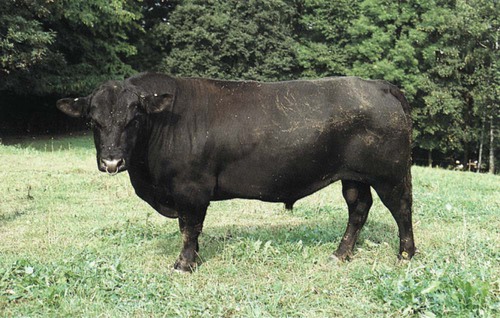
Beefmaster
Brahman
Brangus
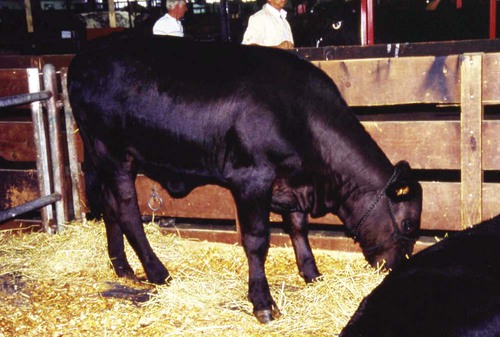
Charolais
Horned and Polled Herefords
Limousin
Maine-Anjou
Red Angus
Santa Gertrudis
Shorthorn
Simmental
Texas Longhorn
Common Breeds of Dairy Cattle
Ayrshire
![]()
Stay updated, free articles. Join our Telegram channel

Full access? Get Clinical Tree


Bovine Husbandry

